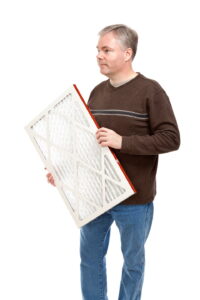If by “furnace repair” you mean taking out a tool kit, opening the furnace cabinet, or anything even close to either, then the answer is a straight no. Furnace repairs, whether for a gas-powered or electric-powered unit, must be left to licensed professionals.
What minor furnace repairs can a homeowner safely handle?
- Replace a clogged air filter
- Reset a tripped circuit breaker in the furnace’s electrical panel
- Check and adjust thermostat settings
- Ensure supply vents are open and unobstructed
- Relight a pilot light (in older furnaces), if it goes out
If the repairs you’re thinking of are more like “troubleshooting” — basic checks to make sure a simple explanation isn’t lurking behind your heating troubles — then there are steps you can take with a malfunctioning furnace. But please know the difference between troubleshooting checks and a DIY repair. See how gas vs. electric furnaces differ when it comes to performance and safety.
“Do-It-Yourself” Furnace Repair Is Potentially Dangerous
We can list many reasons why you must leave repair work for a furnace to an experienced, licensed professional. But safety is the Big One. Gas furnaces are the most common heating system in the Central Valley, and any type of amateur work on a gas appliance is a disaster waiting to happen. Mistakes with gas lines, gas burners, and heat exchangers can expose a household to toxic gases or combustion hazards. Common furnace myths like these often lead to risky decisions by homeowners.
Electric furnaces can create dangers as well if poorly repaired. You don’t want to increase the chance of an electrical fire in your house because of a mistake with wiring.
DIY Repairs May Void Equipment Warranty
Because DIY work is dangerous and often ends up making a furnace worse, it will void most equipment warranties. Keeping the warranty in place is an important consumer protection, since it keeps you from needing to pay for repairs or a replacement due to a manufacturer’s fault. When your furnace is still under warranty, never risk anything that might nullify that warranty.
Pros Will Get Your House Warmer, Faster
A cold winter in the Central Valley isn’t anything you want to deal with in your house for long. Professionals are trained to fix heating systems effectively and efficiently. You won’t have to stay in an ice-box of a home for an extended weekend when you know to call for HVAC technicians rather than attempt a cumbersome fix-it job yourself.
DIY Furnace Troubleshooting: What to Check Before Calling a Pro
What steps can you take with a misbehaving or failed furnace before you call for our help? These checks are ones you can do without fear of creating safety issues or further harming the furnace.
- Check the air filter to see if it’s clogged and replace it if it is.
- If the furnace’s blower won’t come on, check the electrical cabinet to see if the blower motor has tripped a circuit breaker.
- Examine the thermostat settings. It’s easier than you think to make an error with the settings, especially when trying to program a new thermostat.
- Make certain none of the room vents are closed or blocked.
- If you have an older furnace that uses a pilot light, see if it’s gone out. Relight it if it has. If it won’t stay lit, call for professional assistance. You may be able to resolve the issue by trying these furnace troubleshooting tips first before requesting professional help.
We’re the heating contractor in Kerman, CA you can trust to fix your ailing furnace. Our EPA-certified technicians offer fast, reliable repair services.
Frequently Asked Questions
Question: Are there any furnace repairs I can safely do myself?
Answer: Yes, you can do basic troubleshooting steps such as checking or replacing the air filter, ensuring the circuit breaker hasn’t tripped, verifying the thermostat settings, making sure vents aren’t blocked, or relighting a pilot light (if safe and familiar). But avoid opening the furnace cabinet or doing anything inside, leave those to licensed professionals.
Question: Why shouldn’t I try to repair a furnace myself?
Answer: DIY furnace repairs are risky, working on gas lines, burners, or heat exchangers can lead to gas leaks, carbon monoxide exposure, electrical hazards, or fire. Also, unauthorized repairs may void the manufacturer’s warranty.
Question: What common furnace issues can I troubleshoot at home?
Answer: Some typical issues you can check for include a clogged filter (replace it), a tripped breaker in the electrical panel, incorrect thermostat settings, blocked vents, or a pilot light that went out. If problems persist after those checks, call a professional.
Question: What is a cracked heat exchanger and why is it serious?
Answer: The heat exchanger is the component that transfers combustion heat to the airflow without letting exhaust gases into your home. If it cracks, toxic gases like carbon monoxide can leak into your living spaces. It’s a dangerous condition that requires professional repair or replacement.
Question: When is it time to call a furnace technician instead of troubleshooting yourself?
Answer: You should call a technician if you smell gas, if the furnace repeatedly trips electrical breakers, has strange or loud noises, won’t stay lit, or if your attempts at troubleshooting don’t resolve the issue. Also, any internal repairs beyond filter, thermostat, or vent checks should be left to a trained professional.


